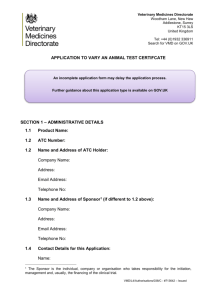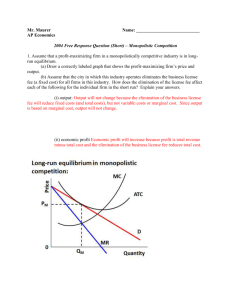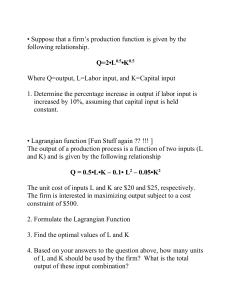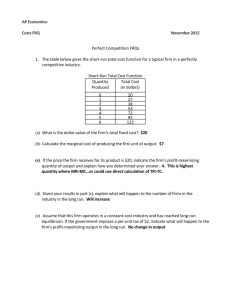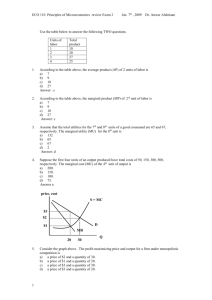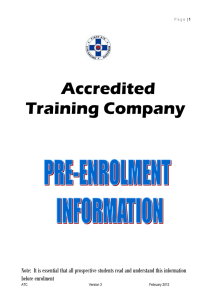Monopolistic Competition
advertisement
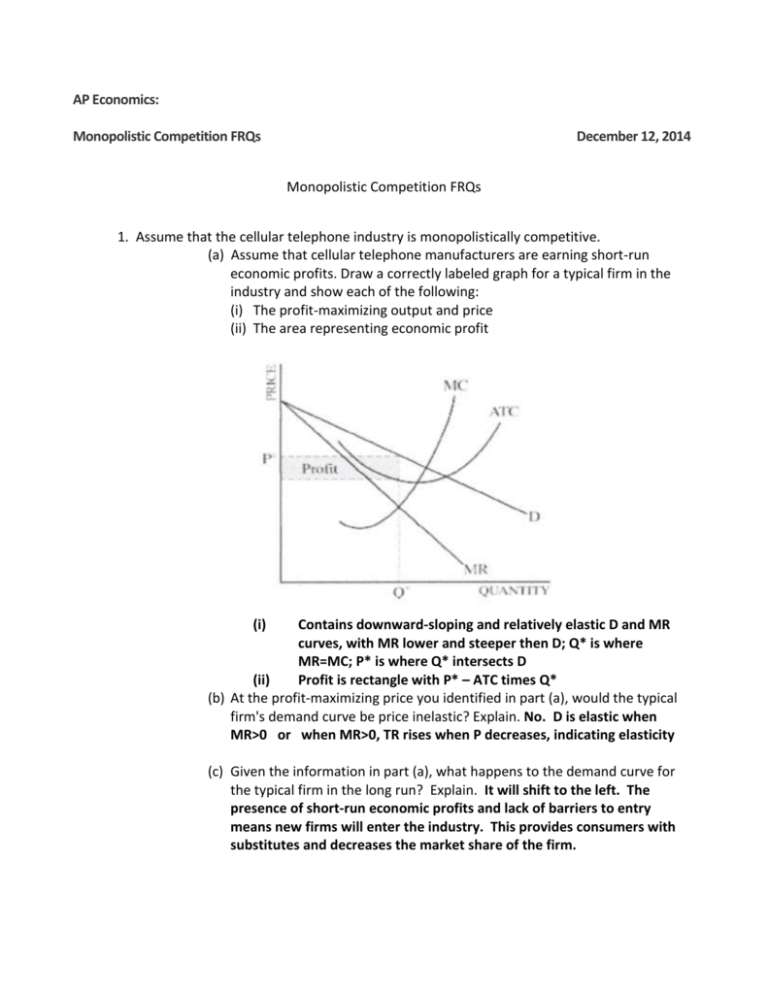
AP Economics: Monopolistic Competition FRQs December 12, 2014 Monopolistic Competition FRQs 1. Assume that the cellular telephone industry is monopolistically competitive. (a) Assume that cellular telephone manufacturers are earning short-run economic profits. Draw a correctly labeled graph for a typical firm in the industry and show each of the following: (i) The profit-maximizing output and price (ii) The area representing economic profit (i) Contains downward-sloping and relatively elastic D and MR curves, with MR lower and steeper then D; Q* is where MR=MC; P* is where Q* intersects D (ii) Profit is rectangle with P* – ATC times Q* (b) At the profit-maximizing price you identified in part (a), would the typical firm's demand curve be price inelastic? Explain. No. D is elastic when MR>0 or when MR>0, TR rises when P decreases, indicating elasticity (c) Given the information in part (a), what happens to the demand curve for the typical firm in the long run? Explain. It will shift to the left. The presence of short-run economic profits and lack of barriers to entry means new firms will enter the industry. This provides consumers with substitutes and decreases the market share of the firm. (d) Using a new correctly labeled graph, show the profit-maximizing output and price for the typical firm in the long run. Properly labeled Q* is where MR=MC P* is where Q* intersects D D is tangent to ATC at Q* and in its downward sloping portion (e) Does the typical firm produce an output level that minimizes its average total cost in the long run? No (f) In long-run equilibrium, does the typical firm produce the allocatively efficient level of output? Explain. No P* > MC 2. Mary & Company, operating in a monopolistically competitive industry, produces a cleaning product called BriteKlean. The company currently produces the profit-maximizing quantity of BriteKlean but is operating at a loss. (a) Draw a correctly labeled graph for Mary & Company and show each of the following: (i) The profit-maximizing output and price, labeled as QM and PM, respectively (ii) The area of loss, shaded completely Proper labeling QM is where MR=MC D and MR are downward sloping, with MR lower than D and steeper PM in where QM intersects D PM is below ATC Loss is rectangle ATC – PM * QM (b) What must be true in the short run for the company to continue to produce at a loss? P > AVC but <ATC or TR>TVC (c) Assume now that the demand for cleaning products increases and that the company is now earning short-run economic profits. Relative to this shortrun situation, how does each of the following change in the long run? (i) The number of firms Increase new firms will enter (ii) The company's profit Profits decrease when new firms enter; in the long run there will be zero economic profit (d) In the long run, if the company continues to produce, will it produce the allocatively efficient level of output? Explain. No P>MC…or…Both D and MR are downward sloping but MR is always <D, so QM (where MR=MC the profit maximizing Q) will be lower than QC (where D=MC - the allocatively efficient Q) (e) In the long run, will the company be operating in a region where economies of scale exist? Explain. Yes. QM will always be in the region where ATC is declining. MC intersects ATC at its minimum; if MC does not intersects MR in the downward sloping portion of ATC, a short-run profit will exist (P>ATC). This will attract new entrants to the industry, causing leftward shifts in D until it is tangent to ATC in its downward sloping region.



